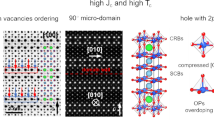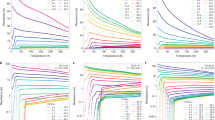Abstract
Finding ways to achieve higher values of the transition temperature, Tc, in superconductors remains a great challenge. The superconducting phase is often one of several competing types of electronic order, including antiferromagnetism and charge density waves1,2,3,4,5. An emerging trend documented in heavy-fermion1 and organic2 conductors is that the maximum Tc for superconductivity occurs under external conditions that cause the critical temperature for a competing order to go to zero. Recently, such competition has been found in multilayer copper oxide high-temperature superconductors (HTSCs3,4,5) that possess two crystallographically inequivalent CuO2 planes in the unit cell. However, whether the competing electronic state can be suppressed to enhance Tc in HTSCs remains an open question. Here we show that pressure-driven phase competition leads to an unusual two-step enhancement of Tc in optimally doped trilayer Bi2Sr2Ca2Cu3O10+δ (Bi2223). We find that Tc first increases with pressure and then decreases after passing through a maximum. Unexpectedly, Tc increases again when the pressure is further raised above a critical value of around 24 GPa, surpassing the first maximum. The presence of this critical pressure is a manifestation of the crossover from the competing order to superconductivity in the inner of the three CuO2 planes. We suggest that the increase at higher pressures occurs as a result of competition between pairing and phase ordering in different CuO2 planes.
This is a preview of subscription content, access via your institution
Access options
Subscribe to this journal
Receive 51 print issues and online access
$199.00 per year
only $3.90 per issue
Buy this article
- Purchase on Springer Link
- Instant access to full article PDF
Prices may be subject to local taxes which are calculated during checkout




Similar content being viewed by others
References
Mathur, N. D. et al. Magnetically mediated superconductivity in heavy fermion compounds. Nature 394, 39–43 (1998)
Uji, S. et al. Magnetic-field-induced superconductivity in a two-dimensional organic conductor. Nature 410, 908–910 (2001)
Mori, M. & Maekawa, S. Effect of antiferromagnetic planes on the superconducting properties of multilayered high-T c cuprates. Phys. Rev. Lett. 94, 137003 (2005)
Mukuda, H. et al. Uniform mixing of high-T c superconductivity and antiferromagnetism on a single CuO2 plane of a Hg-based five-layered cuprate. Phys. Rev. Lett. 96, 087001 (2006)
Chia, E. E. et al. Observation of competing order in a high-T c superconductor using femtosecond optical pulses. Phys. Rev. Lett. 99, 147008 (2007)
Chen, X. J. & Lin, H. Q. Variation of the superconducting transition temperature of hole-doped copper oxides. Phys. Rev. B 69, 104518 (2004); erratum 71, 109901 (2005)
Trokiner, A. et al. 17O nuclear-magnetic-resonance evidence for distinct carrier densities in the two types of CuO2 planes of (Bi,Pb)2Sr2Ca2Cu3Oy . Phys. Rev. B 44, 2426–2429 (1991)
Statt, B. W. & Song, L. M. Screening of the middle CuO2 layer in Bi1. 6Pb0. 4Sr2Ca2Cu3O10 determined from Cu NMR. Phys. Rev. B 48, 3536–3539 (1993)
Ideta, S. et al. Enhanced superconducting gaps in the trilayer high temperature Bi2Sr2Ca2Cu3O10+δ cuprate superconductor. Phys. Rev. Lett. 104, 227001 (2010)
Chen, X. J. et al. Oxidation state of copper and superconductivity in the Hg-Ba-Cu-O system. Chem. Phys. Lett. 258, 1–5 (1996)
Chen, X. J. & Gong, C. D. Dependence of the superconducting transition temperature on the type and number of CuO2 layers in Tl2Ba2Can-1CunO2n+4-y . Phys. Rev. B 59, 4513–4523 (1999)
Gregoryanz, E. A. et al. Superconductivity in the chalcogens up to multimegabar pressures. Phys. Rev. B 65, 064504 (2002)
Sadewasser, S., Schilling, J. S., Paulikas, A. P. & Veal, B. W. Pressure dependence of T c to 17 GPa with and without relaxation effects in superconducting YBa2Cu3Ox . Phys. Rev. B 61, 741–749 (2000)
Chen, X. J. et al. High-pressure phase diagram of Bi2Sr2CaCu2O8+δ single crystals. Phys. Rev. B 70, 214502 (2004)
Kubiak, R. et al. Pressure dependence of the superconducting transition temperature of Bi- and Tl-based high-T c superconductors. Physica C 166, 523–529 (1990)
Gao, L. et al. Superconductivity up to 164 K in HgBa2Cam -1CumO2m+2+δ (m = 1, 2, and 3) under quasihydrostatic pressures. Phys. Rev. B 50, 4260–4263 (1994)
Berman, I. V. et al. Critical temperature of Tl2Ba2Ca2Cu3Ox at pressures of up to 190 kbar. Pis’ma Z. Eksp. Teor. Fiz. 49, 668–671 (1989)
Tristan Jover, D. et al. Pressure dependence of the superconducting critical temperature of Tl2Ba2Ca2Cu3O10+y and Tl2Ba2Ca3Cu4O12+y up to 21 GPa. Phys. Rev. B 54, 10175–10185 (1996)
Zhou, X. J., Cardona, M., Colson, D. & Viallet, V. Plane oxygen vibrations and their temperature dependence in HgBa2Ca2Cu3O8+δ single crystals. Phys. Rev. B 55, 12770–12775 (1997)
Hadjiev, V. G. et al. Strong superconductivity-induced phonon self-energy effects in HgBa2Ca3Cu4O10+δ . Phys. Rev. B 58, 1043–1050 (1998)
Limonov, M., Lee, S., Tajima, S. & Yamanaka, A. Superconductivity-induced resonant Raman scattering in multilayer high-Tc superconductors. Phys. Rev. B 66, 054509 (2002)
Kovaleva, N. H. et al. c-axis lattice dynamics in Bi-based cuprate superconductors. Phys. Rev. B 69, 054511 (2004)
Limonov, M. F., Rykov, A. I., Tajima, S. & Yamanaka, A. Superconductivity-induced effects on phononic and electronic Raman scattering in twin-free YBa2Cu3O7-x single crystals. Phys. Rev. B 61, 12412–12419 (2000)
Feng, D. L. et al. Electronic structure of the trilayer cuprate superconductor Bi2Sr2Ca2Cu3O10+δ . Phys. Rev. Lett. 88, 107001 (2002)
Emery, V. J. & Kivelson, S. A. Importance of phase fluctuations in superconductors with small superfluid density. Nature 374, 434–437 (1995)
Kivelson, S. A. Making high-T c higher: a theoretical proposal. Physica B 318, 61–67 (2002)
Berg, E., Orgad, D. & Kivelson, S. A. Route to high-temperature superconductivity in composite systems. Phys. Rev. B 78, 094509 (2008)
Chen, X. J., Lin, H. Q. & Gong, C. D. Pressure dependence of Tc in Y-Ba-Cu-O superconductors. Phys. Rev. Lett. 85, 2180–2183 (2000)
Yuli, O. et al. Enhancement of the superconducting transition temperature of La2-xSrxCuO4 bilayers: role of pairing and phase stiffness. Phys. Rev. Lett. 101, 057005 (2008)
Acknowledgements
We thank M. R. Beasley, E. Berg, Y. Chen, C. W. Chu, R. E. Cohen, P. C. Dai, D.-L. Feng, E. Fradkin, T. Geballe, C. D. Gong, C.-Q. Jin, S. Kivelson, H.-Q. Lin, O. Millo, D. Orgad, S. Raghu, J. S. Schilling, Z.-X. Shen, L.-L. Sun, J. Tranquada, W.-F. Tsai, N.-L. Wang, H.-H. Wen, Z.-A. Xu, H. Yao, W.-G. Yin, Z.-X. Zhao and J.-X. Zhu for discussions. This work was supported by the DOE under grant no. DE-SC0001057, grant no. DE-FG02-02ER45955 and grant no. DEFC03-03NA00144, and by Carnegie Canada. X.-J.C. acknowledges financial support from the NSFC under grant no. 10874046.
Author information
Authors and Affiliations
Contributions
X.-J.C., H.-k.M. and R.J.H. initiated the program and wrote the paper; X.-J.C., Y.Y. and V.V.S. performed the magnetic susceptibility measurements; X.-J.C., A.F.G. and V.V.S performed the Raman scattering measurements; C.-T.L. synthesized the single crystals; X.-J.C., V.V.S., A.F.G., R.J.H. and H.-k.M. analysed the data and discussed the results. All the authors read and commented on the manuscript.
Corresponding authors
Ethics declarations
Competing interests
The authors declare no competing financial interests.
Supplementary information
Supplementary Information
This file contains Supplementary Data, Supplementary Figures 1 - 4 with legends and References. (PDF 871 kb)
Rights and permissions
About this article
Cite this article
Chen, XJ., Struzhkin, V., Yu, Y. et al. Enhancement of superconductivity by pressure-driven competition in electronic order. Nature 466, 950–953 (2010). https://doi.org/10.1038/nature09293
Received:
Accepted:
Issue Date:
DOI: https://doi.org/10.1038/nature09293
This article is cited by
-
Signatures of superconductivity near 80 K in a nickelate under high pressure
Nature (2023)
-
Unveiling phase diagram of the lightly doped high-Tc cuprate superconductors with disorder removed
Nature Communications (2023)
-
Thermal conductivity of materials under pressure
Nature Reviews Physics (2022)
-
High-pressure studies on pristine and Pb-substituted Bi-based high-temperature superconductor
Bulletin of Materials Science (2022)
-
Fluctuation induced conductivity and pseudogap state studies of Bi1.6Pb0.4Sr2Ca2Cu3O10+δ superconductor added with ZnO nanoparticles
Scientific Reports (2021)
Comments
By submitting a comment you agree to abide by our Terms and Community Guidelines. If you find something abusive or that does not comply with our terms or guidelines please flag it as inappropriate.



